11 Must-have Contact Center Software Features in 2024
Communication channels, such as phone and digital, have become increasingly important in managing interactions with customers since 40% of U.S. consumers positioned “multiple options for communicating” as the most significant aspect of a company’s customer service department.1
These remote channels present immense value potential as customers get more comfortable implementing them. To convert leads and execute value from these customer touchpoints, IT professionals and contact center users need to be aware of must-have contact center software features including their AI implementations.
This article examines the key features of contact center software for companies that aim to offer an end-to-end customer experience.
Contact center software core features
1- Computer telephony integration (CTI)
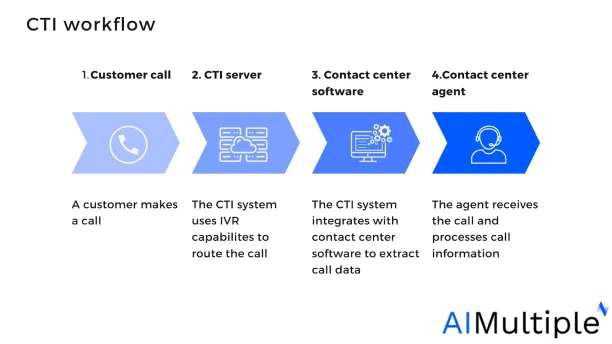
Computer telephony integration (CTI) is the process of connecting a call center’s phone systems to its company programs using voice-over-internet-protocol (VoIP) technology commonly combined with contact center AI tools, often to provide the company’s software with greater authority over call handling.
With CTI, contact center operators do not require actual telephone usage since they may execute all phone tasks on their computer utilizing one-screen commands such as accepting and terminating customer calls, placing callers on hold, or forwarding calls.
Listed below are some common methods for companies to implement CTI into contact center operations:
- Click-to-call: Service center agents can initiate calls from their computers by selecting a phone number.
- Voice to text: Voice communications are converted to text and delivered to an agent’s mailbox for review.
- Customer segmentation: During a phone conversation, a customer’s record shows on an agent’s screen, presenting the agent with the data.
2- Interactive Voice Response (IVR) systems
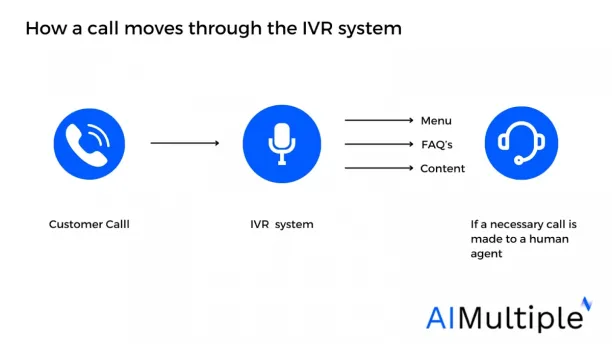
~50% of customers hang up on customer support before their problem is handled. Customer patience is at an all-time low, and robust self-service options are critical for fast issue resolutions.2
Interactive voice response (IVR) is a phone system that distributes incoming calls to the most suitable representative or department by leveraging automatic call distribution (ACD) technology. IVR can communicate with callers and enable them to access information quickly without human intervention by combining text-to-speech and automated scripts with predetermined menu selections.
Here are a few IVR script examples:
“Welcome. Thank you for reaching out to [Company]. Please select one of the following menu items:
- Press 0 for customer service.
- Press 1 for invoicing details.
- Press 2 for technical assistance.
IVRs can also be enhanced to “conversational IVRs” to foster a more tailored service based on customer intent by combining natural language processing (NLP), natural language understanding (NLU), and AI features, allowing users to engage with a self-service options menu using their natural language. Conversational IVRs can leverage call routing to respond, queue, and distribute calls based on call topics and customer attributes, the caller’s native language, or agent availability.
There are three fundamental call-routing methods in contact centers:
- Agent-based routing: Operates by directing inbound calls to the service personnel who have been on the line the longest. Calls are queued until an agent becomes available if all agents are busy with active customer discussions.
- Skill-based routing: Directs customers to agents who have the best ability to address their issues based on agent skill, agent performance, the caller’s native language, or the subject of the call.
- Predictive routing: Analyzes each discussion based on distinctive parameters such as the customer’s previous actions, purchasing habits, or demographics and employs automatic call routing to distribute calls.
3- Predictive dialer
A predictive dialer is an instrument that streamlines outbound calls from customers by dialing. The technology employs an algorithm to forecast outgoing agent availability, assuring optimal efficiency. If a significant number of agents are not free, the predictive dialer will slow down or entirely stop its call distribution until contact center operators become available again.
Given the following example of dialer call data:
- Only one out of every two calls is answered.
- The typical call lasts 90 seconds.
- The average time spent waiting for a call to be responded to is 15 seconds.
Considering these, the dialer places two calls whenever an agent is 75 seconds into their current session. This assures that by the moment the call is over, there is an active customer on the next line waiting to be addressed.
Contact center software management features
4- Low-code / no-code development
Low-code and no-code platforms are both designed to speed process automation while also allowing for scalability across those processes. Our research shows that “ease of use” is the most often searched (11%) favorable phrase for low code – no code development platforms.
- Low-code: Low-code is an interactive method of software development that allows for more rapid delivery of apps with minimum manual coding. A low-code platform’s visual user interface and drag-and-drop capabilities automate elements of the development procedure. Low-code platforms democratize app development, especially for “citizen developers“—enterprise users with no professional coding knowledge, such as business analysts.
- No-code: A no-code development platform (NCDP), like low-code, enables users to develop business apps using drag-and-drop controls rather than traditional manual coding.
5- AI chatbots
Chatbot systems have grown significantly more complex as a result of substantial innovations in the field of AI.
AI chatbots reproduce human talks, cutting wait times and offering a quick, natural, and smooth customer experience by using AI technologies such as machine learning, generative AI, natural language processing (NLP), and natural language understanding (NLU).
AI chatbots help companies to:
- Decrease wait times: ~50% of customers think that waiting too long for responses is the most unpleasant aspect of communicating with businesses.3AI chatbots can help customers spend less time waiting in line, handling messages, calls, or other replies and common inquiries promptly in a conversation screen.
- Handle service cases: ~70% of customers appreciate the simplicity of implementing chatbots on service cases.4Chatbots can help businesses resolve support situations more rapidly, answering simple inquiries for clients to make them pleased.
- Provide self-service automation: ~60% of customers prefer to use a self-service chatbot rather than interacting with a human agent.5AI chatbots can rapidly greet customers with a personalized tone and connect them to existing resources such as FAQs, conversations, databases, or knowledge base articles.
Figure 3: An AI chatbot responding to customer questions
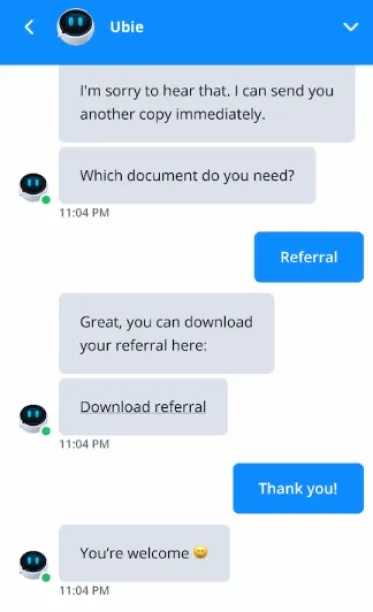
Source: Userlike 6
6- Advanced analytics
Advanced analytics may help organizations proactively enhance contact-center performance across four primary use cases:
6.1 Decrease average handle time (AHT) with text and voice analytics
Text and speech data is constantly created via social media channels, interactions with support agents, surveys, feedback forms, and other sources. To make sense of this data, it must be scraped from all accessible channels (including contact-center records) and then cleaned to eliminate unnecessary words and grammar.
After scraping the data, businesses can use advanced voice and text analytics to lower average handle time (AHT) by searching and mapping through voice and text data in call records to form an automated self-learning solution for better comprehension of client issues.
Figure 4: Illustration of random sampling approach to train, test, and validate data to create intent-based insights with machine learning algorithms
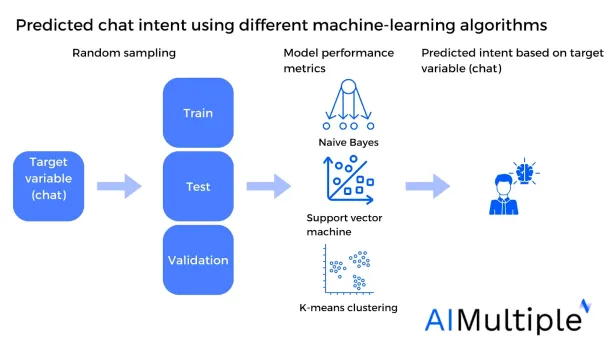
6.2 Reduce call volume
Companies may use advanced analytics to anticipate possible improvements by analyzing text and phone traffic volumes.
An organization, for example, noticed a high volume of repetitive contacts (e.g., 16 calls were received for each 10 consumer complaints).
The organization can examine three key elements using analytics: customers, agents, and procedures.
- Customers: Detect customers who call frequently for little issues, such as status updates on a fixed issue, or those who call again if they are dissatisfied with the first solution.
- Agents: Identify individual performance and detect the agents who have exhibited a poor resolution rate.
- Procedure: Analyze procedures to detect gaps or systemic weaknesses (such as a substitute ID that is not assigned to the customer on time).
6.3 Increase contact center network resilience
Companies can use advanced workforce-management analytics to perform simulations that forecast the effect on customer service for various sorts of interruptions.
A simulation helps realize that a failure to respond to a certain number of customer inquiries in the contact center network could raise the average response time from 10 seconds to 35 seconds. The simulation can also use advanced analytics to create alternative interventions, such as expanding capacity or redirecting calls from customers that can affect contact center response time.
6.4 Enhance sales conversion rate
Advanced analytics solutions can actively generate new income to improve performance. Advanced analytics can achieve this aim by analyzing the characteristics of a client, including real-time data from the present service call, to anticipate the next product or service the customer is most likely to purchase. The analytics can then provide particular next-best-action recommendations to the agent for that customer.
7- Call monitoring
With ~60% of respondents stating that businesses need to care about their customers more, tracking call quality through contact center monitoring technologies is critical for increasing customer satisfaction.7
Call monitoring is an approach of listening in on customer service agents’ conversations to analyze and improve their efficiency. Call monitoring covers all agent-related statistics such as agent accessibility, number of agents in discussion, number of agents logged in, and service level commitment.
There are a few different forms of call monitoring. These are some examples:
- Call listening: When a manager listens in on an ongoing call to take observations and offer criticism later.
- Call barging: When a supervisor immediately intervenes by taking over a live call to assist a distressed agent.
- Call recording: When the call between an agent and customer is recorded for future reviews.
- Call whispering: During a call, a manager speaks privately to an agent without the client on the other end hearing anything.
8- Feedback management
Feedback management is the process of transforming raw customer feedback into meaningful customer insights, which are then used to improve products, services, and engagements. Customer feedback management includes gathering feedback, entering it into a central database, evaluating the data, generating reports, and communicating results with the right teams.
Some of the benefits of feedback management are:
- Analyzing consumer comments with analytics to analyze the voice of customers (VOC).
- Use analytics to analyze consumer comments to acquire customer intelligence.
- Promote brand recognition through the use of the brand’s hashtag on surveys or websites.
- Apply speech-to-text conversion to evaluate feedback in both audio and written formats.
- Compare data-driven agent performance to improve customer retention.
For more on feedback management on social media, read our data-driven and transparent article on social media customer service software.
9- Workforce engagement management (WEM)
Workforce engagement management relates to the technologies used by businesses to foster employee engagement, involvement, and teamwork in customer service. WEM is crucial in contact centers because agents are the first point of contact for customers, as 80% of contact center executives say that improving employee well-being is critical to their organization’s success.8
The activities associated with WEM include:
- Recruitment and onboarding
- Evaluation and improvement
- Data quality management
- Performance management
- Gamification
- Voice of the Employee (VoE) feedback
10- Next best action recommendations
Next best action (NBA) is an AI-powered engagement model that concentrates on delivering hyper-relevant customer experiences in real-time by recommending the most optimal and valuable action to take based on customer profiles.
If a customer abandons their online shopping cart, a next-best action model can suggest sending a targeted email with a discount on the products in the basket to convince customers to complete the transaction.
Companies can use the next best action recommendations to:
- Use AI to manage customer service.
- Offer customer-specific recommendations.
- Improve sales by employing cross-sell and up-sell.
11- Integrations
Contact center integrations connect your contact center software to another form of application or software, such as:
- ERP systems: ERP systems serve as a central hub for any company’s operations. Companies can expedite and optimize critical business activities such as billing, manufacturing tasks, marketing lead monitoring, and more by integrating ERP into their contact center software.
- Customer relationship management (CRM) platforms: When integrated with contact center software, (CRM) systems may improve efficiency and productivity by streamlining a variety of sales, marketing, and service processes.
Once connected, the two apps may automatically share data, resulting in substantial operational benefits listed below:
- Increasing data availability: Data is increasingly spread across numerous settings as enterprises diversify their application landscape (e.g., adopting SaaS apps, and establishing a new cloud contact center solution). Integration tools deployed across any setting offer access to any type of data in any format.
- Address endpoint differentiation: Each software has distinctive features that must be taken into account in any integration, such as error handling, authentication processes, efficiency improvements, and so on. Integration technologies that address these aspects ‘out of the box’ yield significant productivity improvements over programming and resilience.
What is the difference between contact center and call center software?
The distinction between a call center solution and a contact center is based on the methods of communication. While core contact center and call center software features may be used interchangeably there is a systematic difference; call centers mostly rely on traditional phone lines, and contact centers make use of numerous (frequently digital) omnichannel methods.
Further reading
Please read our transparent, up-to-date articles to learn more about customer service software and tools.
- Top 10 Help Desk Software: A Vendor Selection Guide
- Contact Center AI Software: Top 10 Vendors
- Top 7 Contact Center AI Applications: A Holistic Approach
- Social Customer Service Software: Top 10 Vendors
- Top 10 Cloud Contact Center Solutions
Please check our transparent and data-driven software list of our contact center vendors.
External Links
- 1. ”TCN Consumer Survey”. TCN. July 27, 2021. Retrieved December 4, 2023.
- 2. ”Digital customer care in the age of AI”. IBM. Retrieved December 4, 2023.
- 3. Fokina, Maryia. “The Future of Chatbots: 80+ Chatbot Statistics for 2023”. Tidio. April 4, 2023. Retrieved December 4, 2023.
- 4. Leah. ”What Do Your Customers Actually Think About Chatbots?“. Userlike. December 15, 2022. Retrieved December 4, 2023.
- 5. Fokina, Maryia. “The Future of Chatbots: 80+ Chatbot Statistics for 2023”. Tidio. April 4, 2023. Retrieved December 4, 2023.
- 6. Leah. ”What Do Your Customers Actually Think About Chatbots?“. Userlike. December 15, 2022. Retrieved December 4, 2023.
- 7. ”2022-Global-Consumer-Trends-Report.” (PDF). Qualtrics. 2022. Retrieved December 4, 2023.
- 8. ”Deloitte 2021 Global Human Capital Trends Report”. Deloitte. 2021. Retrieved December 4, 2023.

Cem has been the principal analyst at AIMultiple since 2017. AIMultiple informs hundreds of thousands of businesses (as per similarWeb) including 60% of Fortune 500 every month.
Cem's work has been cited by leading global publications including Business Insider, Forbes, Washington Post, global firms like Deloitte, HPE, NGOs like World Economic Forum and supranational organizations like European Commission. You can see more reputable companies and media that referenced AIMultiple.
Throughout his career, Cem served as a tech consultant, tech buyer and tech entrepreneur. He advised businesses on their enterprise software, automation, cloud, AI / ML and other technology related decisions at McKinsey & Company and Altman Solon for more than a decade. He also published a McKinsey report on digitalization.
He led technology strategy and procurement of a telco while reporting to the CEO. He has also led commercial growth of deep tech company Hypatos that reached a 7 digit annual recurring revenue and a 9 digit valuation from 0 within 2 years. Cem's work in Hypatos was covered by leading technology publications like TechCrunch and Business Insider.
Cem regularly speaks at international technology conferences. He graduated from Bogazici University as a computer engineer and holds an MBA from Columbia Business School.
To stay up-to-date on B2B tech & accelerate your enterprise:
Follow on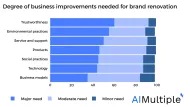
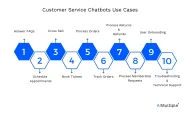
Comments
Your email address will not be published. All fields are required.